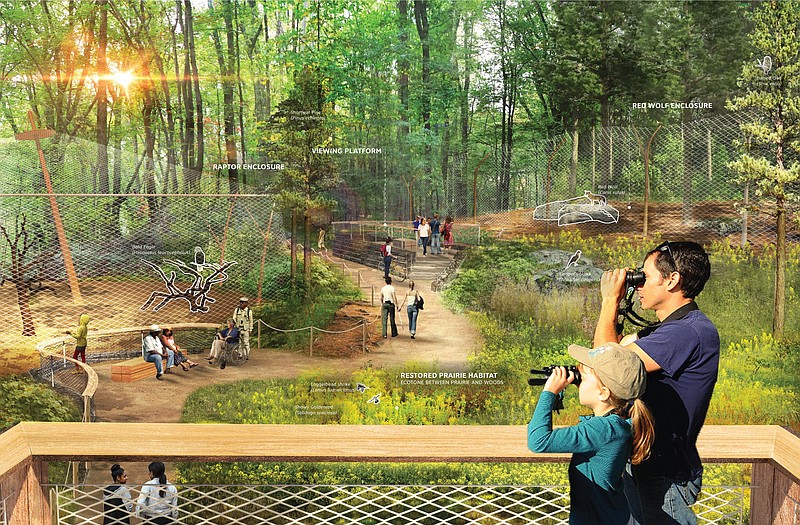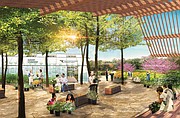Reflection Riding Arboretum and Nature Center last month released a new framework for its future, shifting its conservation efforts to native landscapes in the Southeast and ultimately planning to present those restored ecosystems as learning landscapes for an emerging generation of environmental stewards.
A seven-month engagement and planning process led to the new vision, which is expected to be realized across the site's 300 acres over the next decade.
That site, once the farm of Chattanooga attorney John Chambliss and his wife, Margaret, has for many decades been a drive-through arboretum and nature center.
In 1952, though, when the name "Reflection Riding" first was mentioned in local newspapers, the long-term use of the property was not a given.
Chambliss, referred to in one article as an "attorney, inventor, tourist development man and 'philosopher of fun'," was sure of one thing. The area needed more attractions.
He noted in 1952 to the board of Chattanoogans, Inc., a tourist organization, that Tennessee had dropped from fifth to eighth in 1951 in tourist business among the then-48 states.
In describing his plans for Reflection Riding, which had been in the works for about three years, Chambliss said he hoped to revive the "hanging gardens" idea on the back of Lookout Mountain. His expanse, he said, would offer views of the Indian "face" on the mountain and would feature riding paths, log cabins, streams and historical features. A unique aspect of the area, he said, would be the presence of buffalo, which historian William O. Steele said had once freely roamed the area.
If the tourist site did not become popular, he told the Chattanoogans board, he could turn the area into a residential development.
Fortunately for area residents, Chambliss kept a keen interest in what would now be called the area's biodiversity and its various connections to history. As he did, he kept tinkering with what to do on the land.
Horse trail rides were an early use. One such planned outing in 1952, as described by Mai Bell Conley (who later became several-term Chattanooga City Councilwoman Mai Bell Hurley), was to go from Reflection Riding to the "hanging gardens" area on "paths leading through breath-taking beauty beneath huge ledges abundant in anemone, lilies, blood root, azalia [sic] and mountain laurel."
The buffalo Chambliss promised - a bull and two cows for $840 from the Gene Clark Buffalo Farm in Independence, Kan. - arrived in 1954. He immediately put an ad in the local papers, charging $2 per car to drive through his property and see the new arrivals.
Over the next two years, he hawked the buffalo and sought the tourist dollar, but the ecology of the area seemed to be rising in his thoughts.
"[W]hat I am going to do," he told the Jaycees in an address at the Hotel Patten, "is fix [the property] up so I can charge tourists $2 a throw to ride around it. I figure if I can get one-twentieth of the Rock City trade, I'll be all right."
A newspaper report said Chambliss had spent more than 10 years developing the roads and trails. He had "been careful to keep the natural terrain undisturbed, [where] the visitor feels the presence of nature all about him." Chambliss described the work as "aggressive solitude."
Finally, on Sept. 21, 1957, the state tabbed Reflection Riding a general welfare corporation for continued development as a park and tourist attraction. The corporation, at the time, was adjoined from having any "power to solicit gifts of money ... or raise funds from its members or the public."
Meanwhile, historian Steele was tying the expanse to its place in history, saying it was the crossing point of the "Great Indian War Path" and the "St. Augustine and Cisca Trail," that it was crossed in 1540 by explorer Hernando De Soto looking for gold, that it was crossed - through the Cherokee Nation - in 1807 by the completion of the "Old Federal" Road from Nashville to Augusta, Ga. Finally, as the article author noted, in the 1860s it was the center of "the unpleasantness between the North and the South."
As the 1950s and Reflection Riding's first official years wound down, it got a boost from an easement to plant trees on the west side of Lookout Creek and for 6,000 feet downstream by the Louisville & Nashville Railroad. The trees, shrubs and flowers, it was said, would provide a screen between the arboretum and the new location for the L&N switching yards being built as part of Chattanooga's railroad relocation project.
Seventy years ago this year, Chambliss - who at the time called his expanse Sunset Arboretum - impressed on another civic group the uniqueness of the area by quoting from the book "The Flowering World" by Rutherford Platt.
There existed, the author wrote, "a superb refuge for the richest and most varied forest the world has ever had a large region with copious rainfall, rich soil ... in the southern Appalachians centering around Chattanooga."
Unless perhaps in central China, Platt wrote, "no other region in the world compares ... as a stronghold for the most top-notch flora and living cell ... ever perfected to make mankind's world."
Explaining and preserving that, it seems to us, is what Reflection Riding's new vision and plans are all about and why it is important that the project receives support and public backing as it moves forward.

